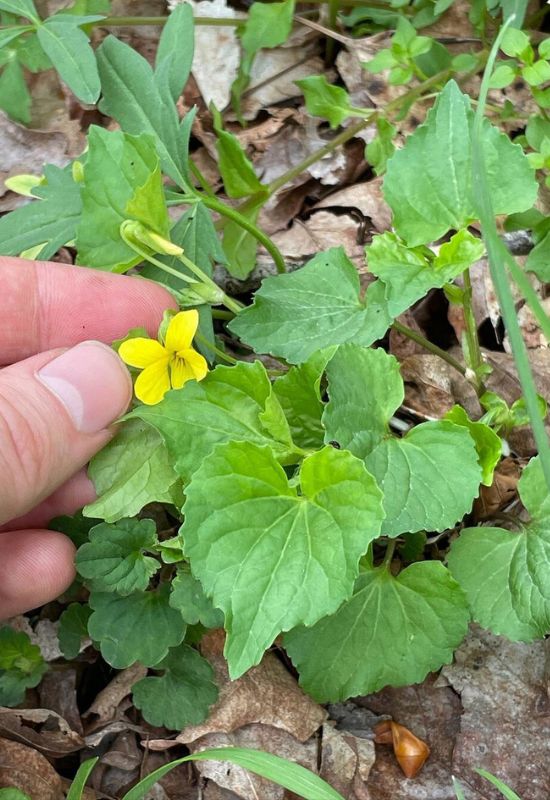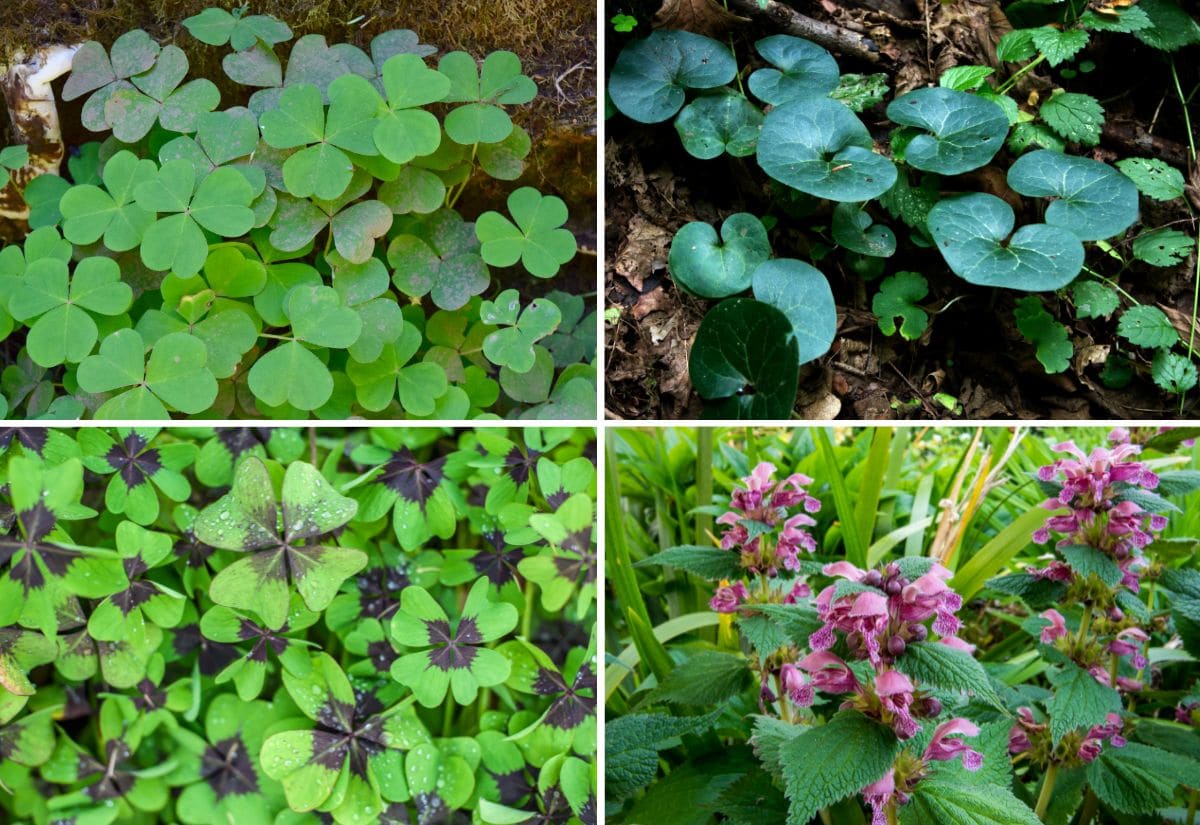
There are weeds that grow on your lawn, under trees and shrubs, or even in your flower beds and they have heart shaped (cordate) leaves? And maybe their romantic foliage is making you think twice before weeding them out…
And you may be right! Growing spontaneously on your land, there may be invasive species and varieties, or others that you can simply keep and enjoy! But you need to identify them first, and the learn how to deal with them – if you have to.
In fact, most weeds with leaves that look like hearts will be fully innocuous, even benign, but others may take over, and you need to know how to control them. And the vast majority will give you colorful flowers as well!
And if you need to recognize spontaneous weeds that have heart-shaped foliage, and then decide what to do you have come to the right place. Let’s see them all and learn what’s best for your garden!
12 Common Weeds Featuring Stunning Heart-Shaped Foliage
If you see lovely heart shaped leaves appearing in your garden, and you did not plant them, the chances are that you are looking at one of these varieties…
And there is also a “bonus mystery weed” at the end. But before you root them out – wait! You may be in for a pleasant surprise!
1. White Violets (Viola spp.)
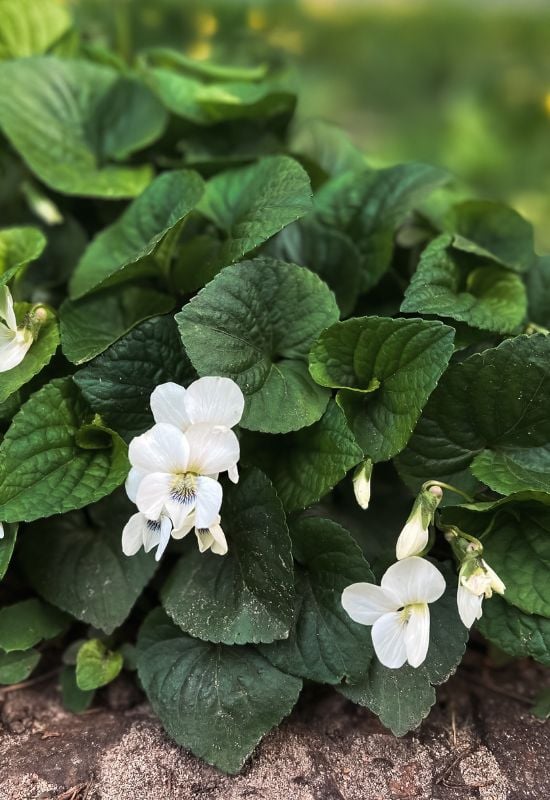
One of the most common weeds with heart shaped leaves that crop up in shady places is also one of the most loved and easily recognized: sweet violets! None will cause any problems to your garden, and in fact, they are usually a welcome sight! But you may want to know exactly which variety you are looking at, and there are quite a few… Look at the color of their flowers, and if it is like snow, there are a few chances…
One of the most common is fragrant Canadian violet (Viola canadensis), often found under trees with small white petals and a few purple lines that lead to a golden center. Sweet white violet (Viola blanda) is similar but with broader petals and no central yellow spot.
Also, the veining is longer and it shades to pale blue… or it could be white striped violet (Viola striata) and in this case, despite the name, you really need to get very close to see the pale blue veins, because they are really short and tiny.
Finally, if your soil is wet, it could be marsh violet (Viola palustris), with bold purple veins and a glow of mauve over the white backdrop. Its leaves are also very rounded, easy to spot!
None of these varieties of white violets will cause you any problems, and the heart felt advise is to just let them grow and bloom! They usually take over in bald patches of land, where you have no other plants, and they provide excellent ground cover!
2. Bermuda Buttercup (Oxalis pes-caprae)
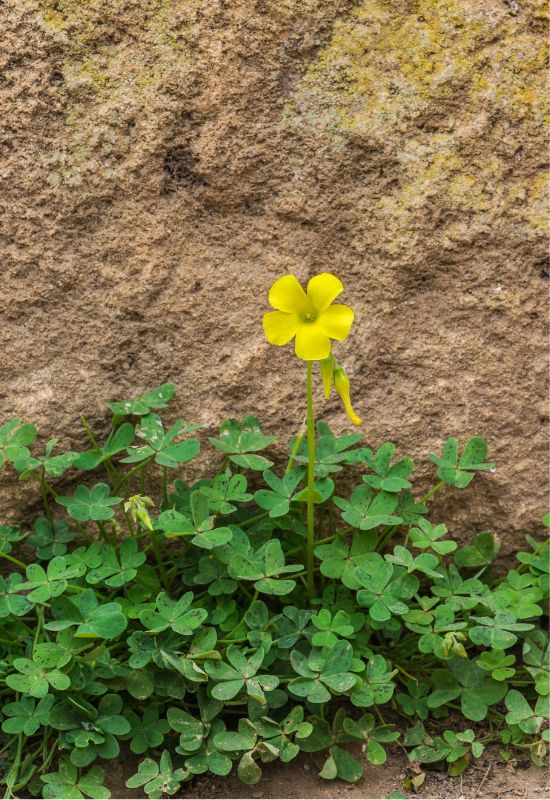
Bermuda buttercup is a very common invasive weed in many warm countries, and it has leaves divided into three green and heart shaped leaflets, deeply dented in the middle, and very fresh looking. They can literally form dense but soft carpets, especially under citrus trees, but for a short time. Then, the plant will die back and hide into the soil.
This usually happens in spring, after it has blossomed. You will see tall and tender stems grow above the leafy blanket, and they will bear quite attractive golden yellow flowers, about 1 inch long (2.5 cm) and that flare to the mouth revealing 6 broad petals.
It can be quite invasive and it can take over quite large swathes of land! But the spectacle is quite inspiring. The best way to recognize it, however, is from its flavor… It tastes very acidic, but in a pleasant way, like a lemonade… And in fact it is edible, and you can add it to your salads, but in small quantities. PS: the blooms taste better than the leaves!
While it is a very beautiful sight, Bermuda buttercup can be quite hard to weed out! While it tends to appear on agricultural or even undisturbed soil when there is little less around, it will definitely make its presence felt – and seen.
3. Lucky Shamrock (Oxalis tetraphylla)
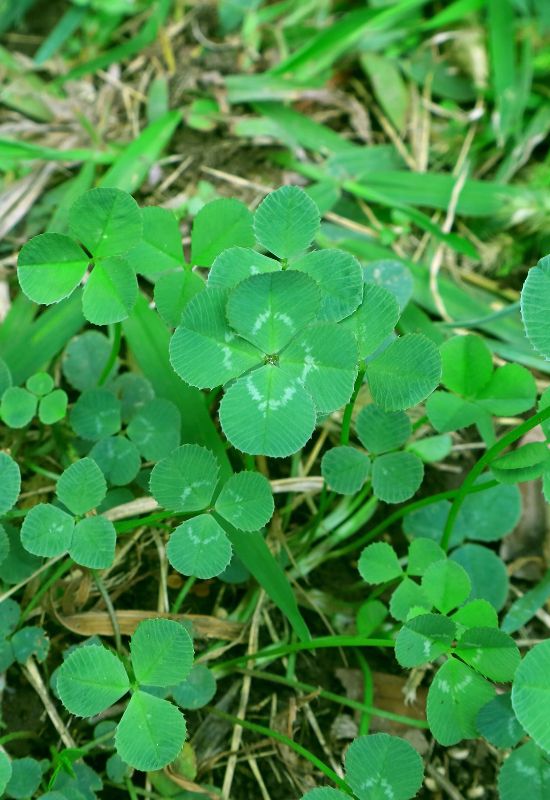
If you see this bulbous perennial weed cropping up somewhere on your land, it’s great news indeed! And in fact, it is called good luck plant, or lucky shamrock. Native of Mexico, it has spread to many places all over the world, also because it is also grown as a decorative variety.
And for good reason… To start with its leaves are divided into four heart shaped leaflets, unlike in clover, where it is usually three, unless you are fortunate… But the bright emerald green of this lovely foliage has a a central purple patch that forms a cross in the middle! This variegation is distinctive and very attractive, as are the little flowers.
Blooming all the way from early summer to fall, it will display sweet looking funnel shaped blossoms of a vibrant rose pink shade, and with rings of white, yellow and green that lead your eye into the throat, where you will see the golden anthers. But I have further positive news for you: this little welcome intruder is by no way invasive!
If you see lucky shamrock coming to your garden or land, your best choice is by far to let it grow freely and enjoy it. It has now become endemic outside its original natural habitat, and if you really want to get rid of it, just mow it down repeatedly, and it will soon vanish.
4. Common Morning Glory (Ipomoea purpurea)
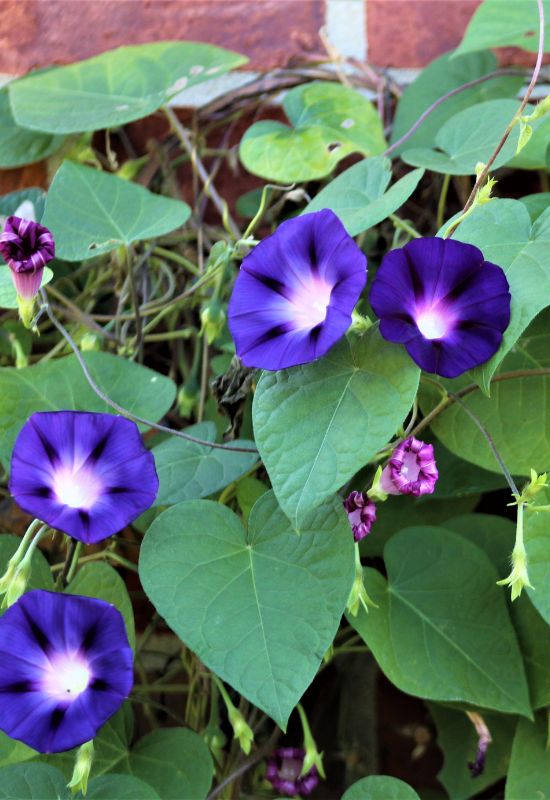
It will be very easy for you to identify common morning glory! To start with you will have seen this climbing weed grow in gardens, over fences and trellises. Next, you will definitely spot the super vibrant violet purple to blue color of its large flowers, which brighten up to a rosy magenta in the center, as if they were lit by a light bulb from behind! And if you need further proof, wait till sunset, and you will see that they fold back…
The blossoms are really showy, between 2 and 3 inches across (5.0 to 7.5 cm) and funnel shaped with a large, open mouth, with a soft but clear hexagonal shape! Some may fade to magenta later in the season as well.
It will appear growing through shrubs or clinging on to gates or similar structures, and it will brighten up your garden from early summer to fall! And another clue is that this floral display attracts lots of butterflies and even hummingbirds! The leaves are large, rich green and soft looking, quite lush as well. Most will be heart shaped, but you may see the odd three lobed one as well! Also, the vine is very thin twining over branches, wires, posts etc.
Common morning glory is so beautiful that you may think you sowed it and you don’t remember. Weeding it is a real pity, but if you had other plans in mind, just cut it or mow it down, and prevent it from seeding. It is an annual and it will soon disappear.
5. Yellow Violets (Viola spp.)
Quite a few wild varieties of violets have yellow as their color, and they may well appear in your garden as “weeds”, though it is hard to call them so, because they are so pretty! And they all have heart shaped – or cordate – foliage. Four are the most common, but you will not be able to identify them by their flowers.
They all have five petals, they are all small and yellow, and they all have purplish veins in the center! However, you can use other traits, like when they blossom. Pioneer violet (Viola gabella) is typical of the Pacific Northwest, and it has a very long season, flowering continuously from early spring to mid summer, with a very intense and dark tonality.
Round leaved violet (Viola rotunidifolia) is not true to its name; its leaves are cordate with serration at the margins, but they are easy to spot because they are fleshy and very glossy, almost semi succulent, and the blossoms are on the lemon side of yellow, opening in mid and late spring only. To recognize cold hardy downy yellow violet (Viola pubescens), look at the small hairs it displays on the stem and leaves, and it blossoms in late spring and early summer.
Finally, you may be looking at evergreen violet (Viola sempervirens) if you don’t live in a very cold country, and it will be hard to tell it apart from pioneer violet… The bloom time is similar, but serration is deeper, and the only way to find out is to wait for winter, because, of course, it is evergreen…
All these yellow varieties will grow in part or full shade places of your garden, bringing a welcome spark of energetic light with their blossoms and ground cover with their heart shaped leaves. They usually colonize neglected areas, and they are usually welcome. Weeding them by hand is easy, but rarely necessary.
6. Dead Nettle (Lamium maculatum and Lamium orvala)
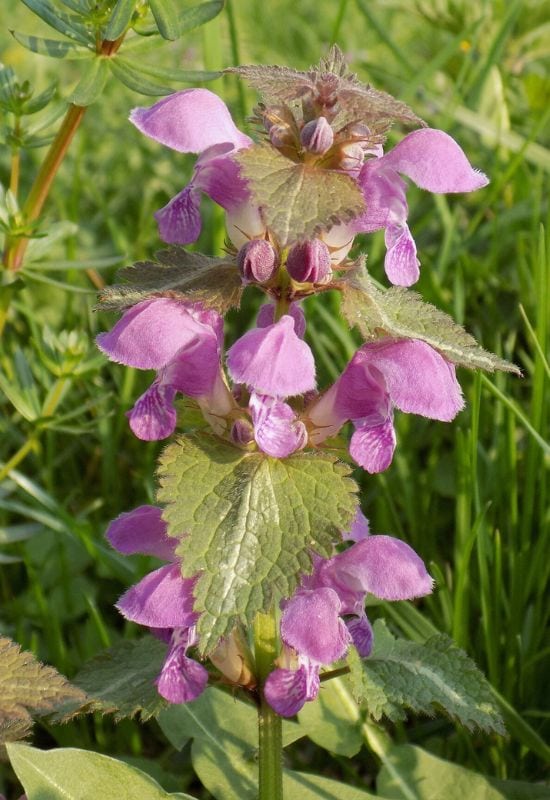
Dead nettle often grows spontaneously at the edges of or even deep inside wooded areas as a weed, and it may or may not have have heart shaped, leaves. There are two main species, or varieties, balm leaved dead nettle (Lamium orvala), which more usually has this shape and common in the wild, and spotted dead nettle (Lamium maculatum), whose foliage can be triangular, oval, or, indeed cordate, and it may have “run away” from gardens. But you will always notice a deep serration and a rough, wrinkled texture.
You can also identify this little perennial because it develops tall and upright stems which has 4 flat sides; its cross section is square. The size may give away the difference, L. maculatum is short but but spreading, while L. orvalacan grow to 18 inches tall and wide (45 cm).
The bloom time is also different, as the bigger sister will start in late spring and end in early summer, while the smaller sibling can begin earlier and keep going till fall! The flowers are at the top, on a spike and they look like little hoods, with a bright magenta purple color… And, as a child, I used to pick them and suck them, because they are very sweet! And pollinators know that too, because that’s all nectar.
While dead nettle is classed as an invasive plant in the USA, it will rarely impact in your flower beds or borders; it prefers wild areas in shady spots, especially if neglected. Weeding it is fairly easy; it has small and shallow roots, and you can easily pull it by the base.
7. Blue Violets (Viola spp.)
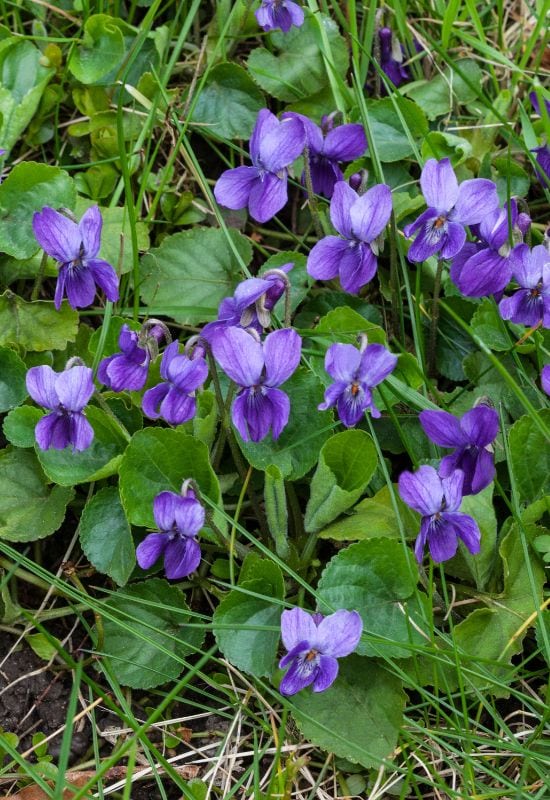
There are many species of wild violets that can bring the color of the sky to your garden uninvited, as weeds. But some don’t have the foliage shape we are looking for. It the leaves are heart shaped, it may be one of a few varieties…
Common blue violet (Viola sonoria) is one of the most common in the USA, and you will identify by its broad deep blue petals, which can turn to violet, and they give you a great display in spring, and smaller bursts till late summer. Furthermore, the leaves can be in a plump cordate fashion, or sometimes also elongated and pointed.
Marsh blue violet (Viola cucullata) will appear in wet soil gardens in North America, as the name suggests, with rich emerald foliage and bright cyan blossoms that open far above, on long stems.
It is quite beautiful, in fact, this weed has won the prestigious Award of Garden Merit by the Royal Horticultural Society! Also coming on tall stems are the blossoms of Clausen’s violet (Viola clauseniana) but not in boggy places, and from mid spring to early summer.
If you see it, report it, because it’s a rare species. The foliage is glaucous and you will notice a white patch on the lower petal. Finally, you may be lucky and be looking at Labrador violet (Viola labradorica), with its purple tinged dark leaves and vibrant lavender blue flowers which may fade to the tips, but they will always have beautiful veins at the center.
If you see blue colored wild violets grow in your garden as weeds, you should be thankful… Their beauty has come for free, and they are not invasive. Your best option is to keep them, but if you want to weed them out, just pull each little plant from the base, or grow a ground cover variety – it will soon take over. Weeding Viola clausenianais banned; it is rare.
8. Velvetleaf (Abutilon Theophrasti)
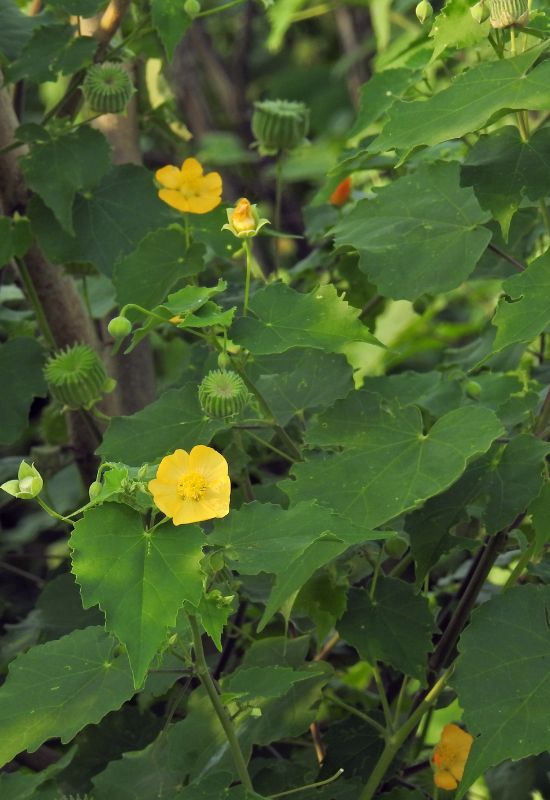
If the heart shaped leaves you see cropping up in your garden are hairy, it may be velveleaf… And it will become a giant in a few months! This native annual or short lived perennial from South Asia is known by many names, like velvet weed, China weed, crown weed, butterprint and Indian mallow. This is because it has been cultivated in China since 2,000 BCE, for its strong fiber (like jute, in fact), but also for its medicinal properties and for food.
Unfortunately, it has become invasive in the USA, Canada and the Eastern Mediterranean… And it can be a problem. Having said this, the fuzzy heart shaped leaves are quite a sight, alternately arranged on the long and upright stalk, reaching 6 inches across and in length (15 cm).
The overall effect may remind you of a sunflower, but if you crush the foliage, it gives off a very unpleasant smell. We cannot say the same of the flowers though. It is indeed an abutilon, related to the prized garden varieties…
The blossoms are cup shaped, with five petals and of the most beautiful golden yellow color, quite shiny, though not big, and blossoming from mid summer to early fall.
They are followed by very decorative seed capsules, with lots of rays… Like a crown in fact – hence one of its names. The actual seeds are edible, but they are a problem… They will spread and take over your land, so, act before it produces them!
In fact, you may enjoy the blossom and foliage, if you want some improvised vertical accent in your garden. But you need to cut it down before it seeds, and you can also remove the roots if you wish, but this is not necessary to weed it out. Alternatively, uproot each plant before it flowers.
9. Young Nettle (Urtica dioica)

If you see fresh looking heart shaped leaves with what appear to be white hairs on them, don’t touch them! Yes, because nettle can have heart shaped foliage, but only when it’s young! And one species in particular, common stinging nettle, or Urtica dioica.
At this stage, they are soft and bright green and honestly not as stingy as later on… Still, they are serrated and unless you know how to handle them with bare hands (lie we gardeners do), avoid them! But as the plant ages, the leaves become darker, narrower and pointed, and in fact, when it reaches maturity, the top ones will be lanceolate (lance shaped).
The blooms start appearing in late spring and they continue into September, but they are not much to write home about… Arching racemes of very tiny flowers if greenish to cream almost invisible blossoms is what you get. And don’t get near to observe them: they have four microscopic petals if you need to know…
Now, the thing is that nettle is excellent for the environment, and it usually grows in neglected, often shady, areas of gardens and fields. But if it bothers you, it’s best to eradicate it when it is young. Wear gardening or protective gloves and pull the plants from the base.
Digging up the soil to remove any roots and especially rhizomes will also help. But don’t throw the nettles away! They are a superfood and great for herb teas, and nettle macerate is the best fertilizer in the whole wide world!
10. Wood Sorrels (Oxalis spp.)
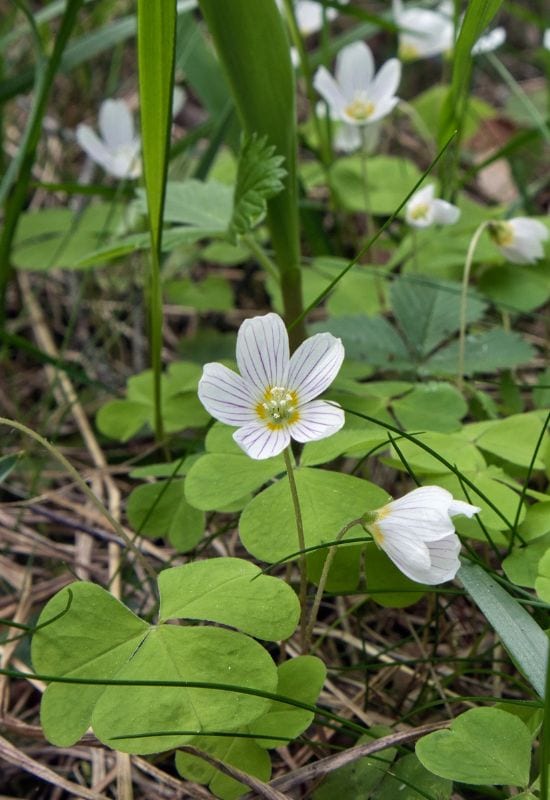
We have already seen two varieties of Oxalis that can grow as weeds in your garden, but there are quite a few, and now we will look at a few common spontaneous species of wood sorrels. Not all have heart shaped leaves, in fact, some have triangular ones, which look like butterfly wings (Oxalis triangularis).
But others have three cordate leaflets, always soft looking and coming on top of a tender stem, and they are also called sourgrasses (for their flavor) or false shamrocks.So, common woodsorrel (Oxalis acetosella) will appear in woody areas, with drooping foliage and quite showy white flowers with delicate grayish veins.
You will find the same color and oattern on Oxalis griffithii, put the petals are smaller and narrower and they lead to a saffron ring in the center. Oxalisdepressa, Oxalis purpurea and Oxalis magnificawill give you blooms in a pink to rose and magenta purplish shade.
So will Oxalis crassipes, but you will identify it because its leaves furl out in the day and fold back at night. In yellow and gold tonalities, there are quite a few… For example, Oxalis luteola, with upward looking blossoms, Oxalis spiralis, with reddish stems, Oxalis grandis, widespread in the USA, and with broad foliage (hence the name).
These wood sorrels can be more or less invasive, depending on the variety; but eradicating them can be a problem, because they are often tuberous and sometime rhizomatous. Having said this, planting stronger species, especially ground cover ones, can lead to their departure. If you want to do a quick job, you will need to dig up the area when they are vegetative and remove all the small tubers and rhizomes.
11. Wild Ginger (Asarum canadense and Asarum europaeum)
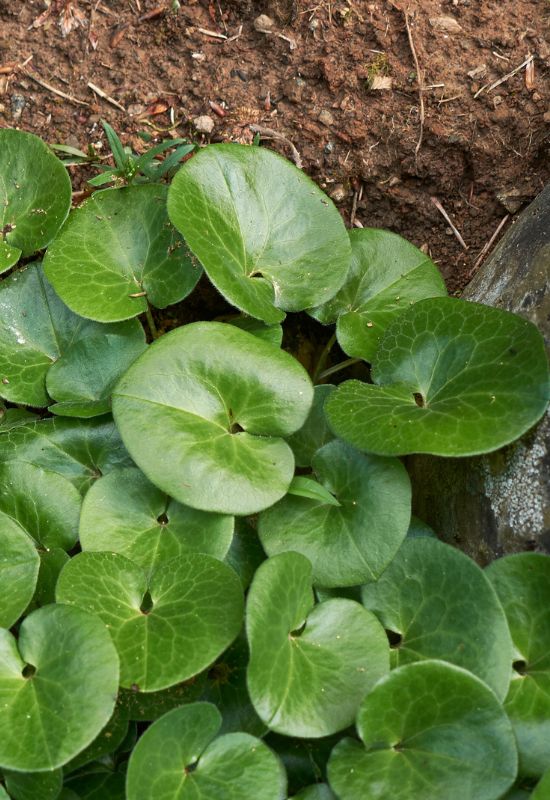
If you live in a woodland area, or if you have clumps of trees, it may just be that the heart shaped leaves you are looking at belong to a variety of wild ginger! The most common in North America is native Canadian wild ginger, a.k.a. snake root (Asarum canadense).
This species will form a dense carpet of tender looking foliage, with just a line of hairs on the margins and quite glaucous in color and big, each being up to 6 inches across (15 cm). If instead the hearts you see are varied in size (2 to 5 inches across, or 5.0 to 12.5 cm), fairly glossy and usually on the olive tonality, you may be staring at western wild ginger (Asarum caudatum).
However, the best way to identify it is by looking at the flowers, because the petals have a long “spike”, or pointed extension. Less common in the Old Continent, but much more widespread in the Old one, is European wild ginger (Asarum aeuropaeum), which is easy to recognize because the cordate leaves are fleshy, almost leathery, dark green with clear veins and a very glossy sheen. And in fact, this weed has won the Award of Garden Merit by the Royal Horticultural Society. These last two species have a peppery snell if you crush them.
The flowers will appear under the foliage, reddish (Asarum canadense) or purple (Asarum caudatumand Asarum aeuropaeum), and they look like urns resting on the side on the ground, with three petals that fold back. And on the outside, you will also see a white downy fuzz!
Canadian and western wild ginger will spread fast, while the European variety will do it slowly. They are usually welcome intruders, excellent ground cover. But if you really want to weed them out, pull each plant and then dig the soil to remove all rhizomes. Alternatively, grow stronger groundcover varieties.
12. Violet Violets (Viola spp.)
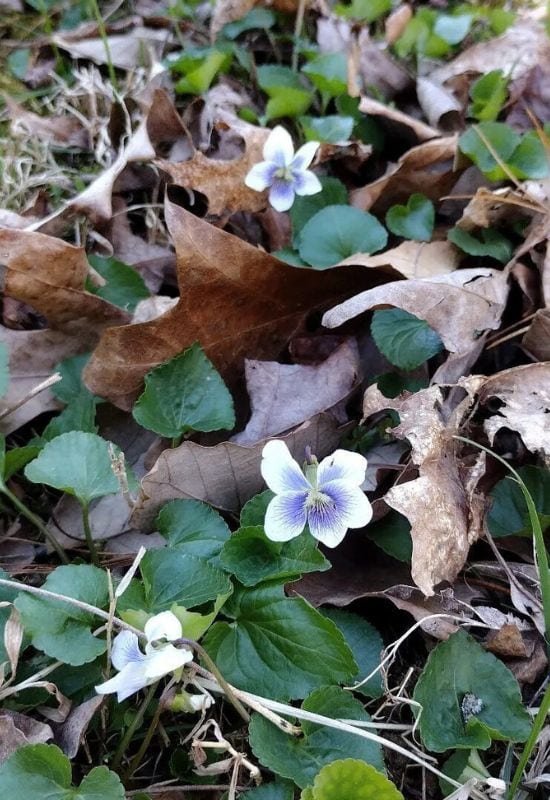
The color violet comes from the flower, not the other way round… And, of course, there are many varieties in this elegant chromatic range… And most may crop up in your garden as (usually more than welcome) weeds, with heart shaped leaves, of course. Let’s see some of the most probable…
Native of North America, western blue violet (Viola adunca) is actually lavender violet in color… The blossoms are quite big, about 1 inch across (2.5 cm) and they bace gentle darker veins on the petals.
The leaves have fairly smooth edges, with light dents. Also coming from, and typical of the USA is sand violet (Viola affinis), and you can identify it by the deeply cut margins of the foliage, and the fact that the veins only occur in the lower petal.
On the other hand, field pansy (Viola bicolor) can grow in sunny spots too, and the blossoms may be pale violet or blue, but they have a distinctive yellow parch in the center.
Cold hardy and popular in the Norther States, Alaska violet (Viola langsdorffii) prefers wet soils, and it has quite large flowers, up to 1.3 inches across (3.2 cm) and opening on tall stems (12 inches, or 30 cm tall).
It is used as food, as it is rich in Vitamin C. Still from similar regions and climates, long spurred violet (Viola rostrata) has smaller flower heads, pale, veined, but very glossy deep emerald foliage.
Finally, the most common species in Europe, maybe in the world, sweet violet(Viola odorata) can be blue or violet, with no veins, but always very vibrant, intense and bright in shade – and always fragrant!
I doubt that you would like to weed out plants such beautiful flowers and heart shaped leaves… They are not even invasive, and they colonize neglected areas. But if you have to, pull each plant from the base, or simply grow stronger ground cover varieties.
Bonus “Mystery Weed”
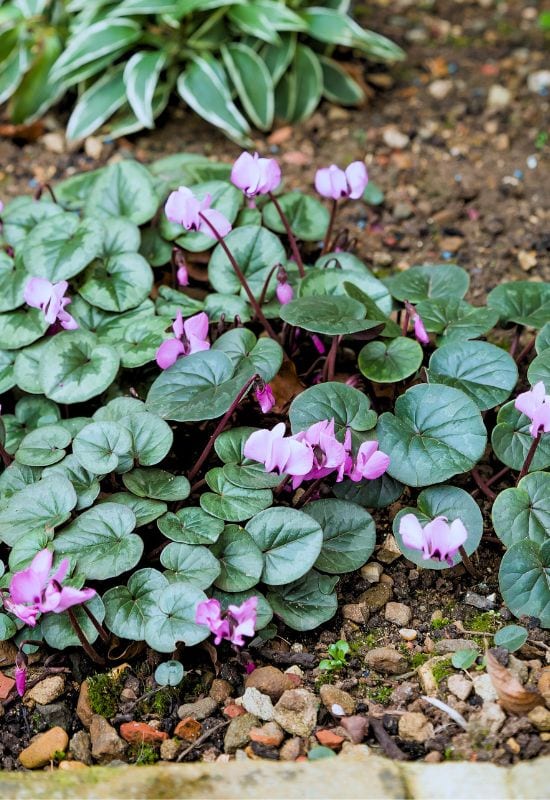
If you see lovely heart shaped leaves growing maybe under trees, and they are quite glossy, deep green, you may be in for a good surprise! In fact, it may just be that one of the wild and spontaneous varieties of Cyclamen has found its way to your woodland garden! Most species hail from Europe and the Middle East, but they have found their ways to shady areas of the New World as well…
The most common is also known by the name of Persian violet (Cyclamen coum), which is also a well loved as a decorative perennial, and, in fact, it has won the Award of Garden Merit by the Royal Horticultural Society! You will see deep forest green and brighter, pale and even silvery spots on the glossy foliage. Then attractive reflexed rosy pink blooms with reflexed petals will appear on hooked stems… And this will happen very early in the season, from late winter.
Very similar is also Cyclamen alpinum, but it will grow at high altitudes, and it will give you its floral display in the midst of winter! If instead the flowers appear in early fall, and they are quite slender, with pointed tepals, and in a pale lavender shade, you may just be looking at Cyclamen cilium. Other varieties may be coming to live with your trees and shrubs uninvited, but they these are the most likely…
Why would you ever want to weed out these beauties? Cyclamens grow in neglected areas, often where very little else thrives, like under conifers. They can spread fast and give you amazing spectacles, but they are nit aggressive. If you really, really want to get rid of them, uproot all the tubers, and maybe sell them on…
Spontaneous, Heart Shaped Weeds – Not Always Bad News!
As you can see, those lovely heart shaped leaves may be welcome news, even winners of the most famous garden prize in the world may have set roots uninvited in your garden. A few may be a problem though; and now you know how to weed them out, in case…

Written By
Margie Fetchik
Margie and Arkansas native has an extensive background in gardening and landscaping. For the last 40 years, Margie has called the Colorado Rocky Mountains her home. Here she and her husband of 36 years raised three kids and owned a successful landscaping company. Margie has a CSU Master Gardener certification. She specialized in garden design & installation, perennial gardens, turf grasses & weeds, flower containers, and the overall maintenance of allHOA, commercial and residential accounts. She and her husband now reside in Denver and are excited about the new experiences’ city life holds.

